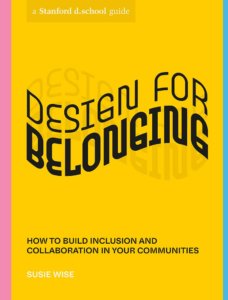
In her Stanford d.school guide and book, Susie Wise offers a framework for belonging that rests on nine parts of a journey or community experience — from the first touchpoint, the invitation to join or participate, to an intentionally designed ending. (© 2022 by Rose Jaffe)
Designer Susie Wise has taught for 15 years at the design school at Stanford University, where, among other things, she founded a lab that explores how design thinking can be applied to education. Wise, who has a Ph.D. in learning sciences and technology design from Stanford, also has worked for tech companies, an art museum, nonprofits, and cofounded an Oakland elementary school, among other roles.
Her work is varied, “but all of it is rooted in belonging,” Wise wrote in Design for Belonging: How to Build Inclusion and Collaboration in Your Communities, published earlier this year by the Stanford d.school. In looking for new ways to help people learn and interact with one another, her own experience and research — as well as the research of others — have led her to recognize that “belonging is the thing that matters most,” Wise wrote. “Having a sense of belonging leads to flourishing in every environment and group, big and small, from your home to the culture at large.”
Her book is very much related to this moment in time, because “I’m really interested in helping people move forward to be more inclusive, to build belonging, and to reduce othering — and to do that creatively,” Wise told Convene Deputy Editor Barbara Palmer recently over a chai latté at a coffee shop in downtown Oakland, California, where they both live. “There’s the resurgence of Black Lives Matter and a broader cultural understanding of the work needed to be done to change our culture to be truly more inclusive. There’s also this moment — pandemic, post-pandemic — where people are trying to figure out how to be together. There are multiple dimensions where people need to figure out how to be together. And belonging is at the core of that.”

Susie Wise
One of the frameworks Wise offers rests on recognizing the opportunities in what she calls “moments of belonging.” (See “Nine Moments of Belonging” below.) Belonging is a feeling, and you can’t design a feeling, she notes in her book. “But you can learn to recognize how and when feelings arise and then design all kinds of things that positively influence those feelings,” she writes, including things like the environment, rituals, and ways of communicating.
“The work of the design part of belonging is to remember our inherent creativity and that one of the ways to change culture — to change the way we come together — is to try things and see what works and what doesn’t,” she said. “What does it really mean to participate? What does it mean to contribute? What does it mean to dissent or offer critical feedback? These are all important moments to design for from an experience design perspective. And we can tune them to be more about belonging.”
Conferences, “because they are pop-up experiences,” she said, “are amazing opportunities for experiments. My position is always to think creatively and come up with what’s going to make sense in your own context. For example, classic things — like, do we wear lanyards? — can be totally rethought in terms of what’s going to be authentic.
“Or, how do you tell your story? I think when we’re thinking about inclusion, opportunities to tell your story and have it show up, then, in real time are really powerful.
“It’s one thing to share who you are on an app,” Wise continued. “But what if those stories moved from the app and showed up in the physical space?” Photos and text could be projected on the walls, she said, “and it could be a way that you could walk into an immersive space of: ‘These are all the kinds of people that are going to be here!’”
We’re often in situations where we just assume that everything will be how it’s always been, “but the pandemic and the resurgence of a racial justice awakening is an opportunity is to say things can be different,” Wise said. “And that means opening up to the way that things concretely can be different — space can be different, time can be different. The way we ‘group up’ can be different. And these are all levers for designing conferences.”
There is a big difference, she added, between designing with and designing for. “The history of design is old, white dudes sitting in a room designing something and then shipping it out to the world,” she said. “In co-design, we understand — especially if we’re working on social challenges — that we want to be in close proximity and really honoring the lived expertise of people who are experiencing the challenges or opportunity that we’re trying to work on.”
And from a conference perspective, it is really important to think about the communities where events are held, she said. “You don’t want to just be coming in, right? You’re coming in and taking over and, yes, you’re bringing economic benefit, but could you, with just a little more design consciousness, actually build a different kind of relationship that is authentically supportive of the community members who are going to be there when the conference leaves? If you think you’re designing an event,” Wise said, “the bigger thing that you’re doing is building community.”
Nine Moments of Belonging
The list of “moments of belonging” that designer Susie Wise provides in her book Design for Belonging: How to Build Inclusion and Collaboration in Your Communities is just a starting point, she writes. The following is adapted from her book and a Convene conversation with the author.
 1. The Invitation
1. The Invitation
An invitation is the first opportunity to create a moment of belonging — a great invitation speaks to your audience with a clear purpose. It is critical to be clear about who you seek to engage and to understand why they may not have been — or have not felt they were — invited before.
2. Entering
Because the entry creates a first impression and sets a tone, it’s important to put belonging up front. Pay attention to patterns. Do people of particular backgrounds feel invited in, but then stumble at the entry? Follow up to understand who feels they can join the story and who does not.
3. Participating
The best part of belonging is full participation, which requires attention to many details, from checking in to inquiring explicitly about how people are doing, to inviting reflection and feedback on how it feels to be part of the work or organization. All the things we know about building in reflection moments will help both with attendees’ learning and their sense of being a part of something.
4. Code Switching
The concept was pulled from linguistics into broader use as a way to understand the relationships between white dominant culture and other non-dominant cultures. It’s an incredible skill of adaptation and an ability to move fluidly between contexts, and it can also entail a cognitive load that can be draining.
5. Contributing
One of the key moments of belonging is contribution. “Giving something matters, but seeing it be received is what really lets you know that you belong.”
6. Flowing
Coined by psychologist Mihaly Csikszentmihalyi, flow comes from full immersion in the task at hand. When you are in flow, you’re not wasting resources on wondering whether you are part of the community; instead, you know you are. Places where you can see flow at a conference include where there is “play” activity and hearing the hum of conversation.
7. Dissenting
Communicating dissent is evidence that you trust in your community. You are likely to raise issues, challenge authority, or push beyond the status quo only if you have a sense of belonging. Ask yourself: What would it look like to build in more opportunities to hear and learn from dissenting views? What kind of pop-up spaces can we create where we purposely are trying to get opposing points of view? And that could be asking people with opposing points of view if they are willing to stand up and share them.
8. Repairing
What do you do if you heard something that made you really uncomfortable? Where is the safe space to say something didn’t work? It could be a physical space or it could be a digital space; it could be embodied by a person, but you have to have a place to go to say, “This doesn’t feel good.”
9. Leaving and diverging
If we are building true belonging in our groups, we will always be accommodating of diverging paths — the modifications that participants make to the learning experiences we design, like arriving late or leaving early. We stop and start at different times. We learn at different paces. Having different kinds of people at different stages in their lives will invariably push you to create more paths. Design for endings with as much intention as you design the invitation.
Barbara Palmer is deputy editor of Convene.
Reprinted with permission from Design for Belonging: How to Build Inclusion and Collaboration in Your Communities by Dr. Susie Wise and the Stanford d.school, © 2022. Published by Ten Speed Press, an imprint of Penguin Random House. Illustrations © 2022 by Rose Jaffe.
